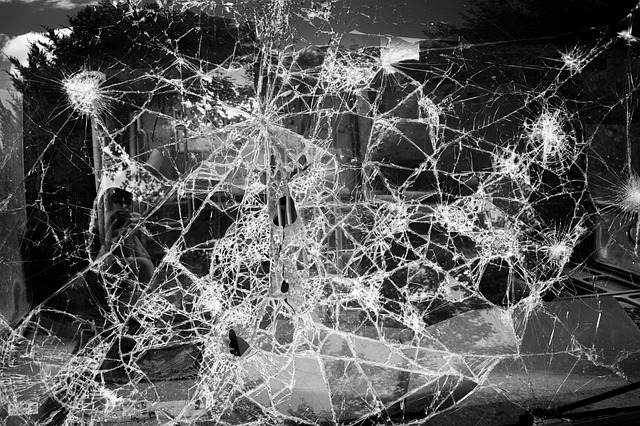Laminated glass
Contents |
[edit] Introduction
Laminated glass (sometimes called toughened laminated glass) comprises two or more layers of glass sandwiched together with tear-resistant plastic film interlayers (usually polyvinyl butyral (PVB) or ethylene-vinyl acetate (EVA). The aim is to create a glass composite which can absorb the energy of a person or object that strikes it, preventing penetration of the pane and potential injuries that might result from flying fragments of broken glass.
An additional benefit of laminated glass is that most ultraviolet radiation can be blocked by the PVB or EVA interlayer. Thermoset EVA layers can block up to 99.9% of UV rays.
[edit] Applications
Laminated glass can be used for safety or security reasons. It is used for architectural applications where for example, the glass could fall from a height and shatter, and also for roof, balcony and terrace balustrading, as well as for skylights. It can also be used as a decorative material due to the wide variety of interlayers available, e.g coloured, textured, meshed or patterned. It is particularly useful for windows and shopfronts in areas prone to hurricanes.
In addition to flat sheets, it can be supplied in curved sections, as may be required for car windscreens.
[edit] Manufacture
Bonding together the alternating layers of, typically annealed glass, and plastic film is usually achieved through the use of heat and pressure created by an autoclave.
Manufacture can involve using heat-strengthened glass, which, when it breaks, does so into large pieces held in the frame by the PVB inter-layer. Or it can be made from tempered glass, where the sheet may fall out of the frame but will mostly stay together due to the interlayer.
Digital printing for special effects can be created by printing on to the glass prior to laminating or printing onto the interlayer.
[edit] Configurations
Laminated glass is available in various thicknesses and configurations. A typical glass-layers configuration can comprise 2.5mm glass – 0.38mm interlayer – 2.5mm glass, resulting in ‘5.38 laminated glass’.
Thicker glass and multiple laminates giver a stronger product. Thicker configurations such as double– or triple-laminate with interlayers (int) can include the following:
[edit] Double laminate:
- 6mm - int - 6mm.
- 8mm - int - 8mm.
- 10mm - int - 10mm.
[edit] Triple laminate:
- 6mm - int - 6mm - int -6mm.
- 8mm - int - 8mm - int -8mm.
- 10mm - int - 10mm - int -10mm.
The cockpit of an aircraft such as a Boeing 747 may include a triple-laminated glass construction comprising three layers of 4mm toughened glass with 2.6mm PVB layers in between, making a total glass thickness of 17.2mm.
[edit] Related articles on Designing Buildings Wiki
- BFRC window rating scheme.
- BREEAM Visual comfort View out.
- Curved glass.
- Daylit space.
- Domestic windows.
- Double glazing.
- Emissivity.
- Float glass process.
- Glass.
- Low-E glass.
- Overheating.
- Patent glazing.
- Preventing overheating.
- R-value.
- Rights to light.
- Safety glass.
- Secondary glazing.
- Security glazing.
- Structural glass assembly.
- Suction lifter.
- Types of window.
- U-value.
- Window.
Featured articles and news
International Electrician Day, 10 June 2025
Celebrating the role of electrical engineers from André-Marie Amperè, today and for the future.
New guide for clients launched at Houses of Parliament
'There has never been a more important time for clients to step up and ...ask the right questions'
The impact of recycled slate tiles
Innovation across the decades.
EPC changes for existing buildings
Changes and their context as the new RdSAP methodology comes into use from 15 June.
Skills England publishes Sector skills needs assessments
Priority areas relating to the built environment highlighted and described in brief.
BSRIA HVAC Market Watch - May 2025 Edition
Heat Pump Market Outlook: Policy, Performance & Refrigerant Trends for 2025–2028.
Committing to EDI in construction with CIOB
Built Environment professional bodies deepen commitment to EDI with two new signatories: CIAT and CICES.
Government Grenfell progress report at a glance
Line by line recomendation overview, with links to more details.
An engaging and lively review of his professional life.
Sustainable heating for listed buildings
A problem that needs to be approached intelligently.
50th Golden anniversary ECA Edmundson apprentice award
Deadline for entries has been extended to Friday 27 June, so don't miss out!
CIAT at the London Festival of Architecture
Designing for Everyone: Breaking Barriers in Inclusive Architecture.
Mixed reactions to apprenticeship and skills reform 2025
A 'welcome shift' for some and a 'backwards step' for others.
Licensing construction in the UK
As the latest report and proposal to licence builders reaches Parliament.
Building Safety Alliance golden thread guidance
Extensive excel checklist of information with guidance document freely accessible.
Fair Payment Code and other payment initiatives
For fair and late payments, need to work together to add value.
Pre-planning delivery programmes and delay penalties
Proposed for housebuilders in government reform: Speeding Up Build Out.
High street health: converting a building for healthcare uses
The benefits of health centres acting as new anchor sites in the high street.

























